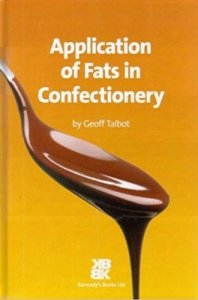Ref: FI002
EUR 130,-
excl. VAT + postage
Application of Fats in Confectionery
by Geoff Talbot
Kennedys Publications Ltd
Publication: First published July 2006
ISBN: 978-0-9558085-3-1
Geoff Talbot’s book is the culmination of nearly 40 years in the fats world and fills a gaping hole in the existing literature.The book is intended to help non-specialists and specialists alike understand the nature of fats and the appropriate analytical approaches. He covers the kinds of fats and oils used in confectionery, how they are processed and then focuses on their use in chocolate, compound coatings and confectionery fillings.
Content
1 Organic, Physical and Analytical Chemistry of Fats
1.1. What are fats?
1.2. Fatty acids
1.3. Triglycerides
1.4. Stability
1.4.1. Oxidation
1.4.2. Hydrolysis
1.5. Chemical Analysis
1.5.1. Free fatty acid
1.5.2. Peroxide Value and Anisidine Value
1.5.3. Rancimat Induction Period
1.5.4. Iodine Value
1.5.5. Sensory properties
1.6. Physical Analysis
1.6.1. Melting characteristics
1.6.2. Crystallisation characteristics
1.7. Spectroscopic and Chromatographic Analysis
1.7.1. Spectroscopic methods
1.7.2. Chromatographic methods
1.8. Polymorphism
1.9. Eutectics
2 Oils and Fats used in Confectionery
2.1. Cocoa butter
2.2. Palm oil
2.3. Lauric fats
2.3.1. Palm kernel oil
2.3.2. Coconut oil
2.4. Exotic oils
2.4.1. Illipe butter
2.4.2. Shea butter
2.4.3. Sal oil
2.4.4. Kokum oil
2.4.5. Mango kernel oil
2.5. Liquid oils
2.5.1. Rapeseed oil
2.5.2. Soyabean oil
2.5.3. Sunflower oil
2.5.4. Cottonseed oil
2.5.5. Groundnut oil
2.6. Milk fat
3 Processing of Oils and Fats
3.0. Introduction
3.1. Expelling and Extraction
3.2. Refining
3.3. Fractionation
3.4. Hydrogenation
3.5. Rearrangement
4 Chocolate
4.1. Background and history
4.2. The fat phase of ‘traditional’ chocolate
4.3. Cocoa butter fractions
4.4. Milk fat fractions
4.5. Cocoa butter equivalents
4.6. Legislation
4.6.1. European Union
4.6.2. United States
4.6.3. Codex Alimentarius
4.7. Chocolate production – general outline
4.7.1. Mixing
4.7.2. Refining
4.7.3. Conching
4.8. Effects of the chocolate fat phase on process and product
4.8.1. Tempering
4.8.2. Viscosity
4.8.3. Moulding
4.8.4. Enrobing
4.8.5. Crystallisation
4.8.6. Hardness
5 Compound Coatings
5.1. Cocoa butter alternatives
5.1.2. Cocoa butter equivalents
5.1.3. Cocoa butter replacers
5.1.4. Cocoa butter substitutes
5.2. Effect of the fat phase on the coating recipe
5.2.1. Supercoatings
5.2.2. Non-lauric CBR coatings
5.2.3. Lauric CBS coatings
5.3. Effect of the fat phase on process variables
5.4. Summary
6 Confectionery Fillings
6.1. Introduction to fillings
6.2. Formulation of fillings
6.3. Types of filling fat
6.3.1. Polymorphic fats
6.3.2. Non-lauric, non-polymorphic filling fats
6.3.3. Lauric filling fats
6.3.4. Nut oils
6.4. Choice of fat for various types of filling
6.4.1. Cool-melting fillings
6.4.2. Shell-moulded fillings
6.4.3. Aerated fillings
6.4.4. Extruded fillings
6.4.5. Biscuit or wafer creams
6.4.6. Bake-stable fillings
6.4.7. Liqueur centres
6.5. Toffees and Caramels
6.5.1. Characteristics of toffee fats
6.5.2. Distinction between various types
6.5.3. Hardness and crystallization
6.6. Summary
7 Ice Cream
7.1. Fats used in ice cream
7.1.1. Different types and origins
7.1.2. Functionality of the fat in ice cream
7.1.3. Requirements and choice of fat
7.2. Fats used in ice cream coatings.
7.2.1. Chocolate coatings
7.2.2. Compound coatings
8 Problem Areas
8.1. Heat resistance
8.1.1. Modification of the fat phase
8.1.2. Modification of the chocolate
8.2. Fat migration
8.2.1. Effects of migration
8.2.2. Factors affecting fat migration
8.2.3. Measuring the extent of fat migration – the ‘washer test’
8.2.4. Reducing fat migration
8.3. Fat bloom
8.4. Moisture migration
8.4.1. Measurement of permeability
8.4.2. Moisture barriers based on triglycerides
8.4.3. Moisture barriers based on waxes
8.5. Trans fatty acids

